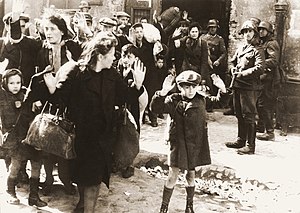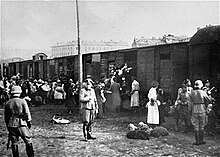Warsaw Ghetto boy
In the best-known photograph taken during the 1943 Warsaw Ghetto Uprising, a boy holds his hands over his head while SS-Rottenführer Josef Blösche points a submachine gun in his direction.
The Germans had to set the ghetto on fire, pump poison gas into bunkers, and blast the Jews out of their positions in order to march them to the Umschlagplatz and deport them to Majdanek and Treblinka.
During the suppression of the uprising, Stroop sent daily communiqués to Higher SS and Police Leader Friedrich-Wilhelm Krüger in Kraków; Propaganda Company 689 and Franz Konrad took photographs to document the events.
[9][10] Selected photographs and communiqués were compiled, along with a summary of German actions, as the Stroop Report, a personal souvenir for Heinrich Himmler.
[12] The report memorialized the supposed heroism of the SS men who participated in the suppression of the uprising, especially the sixteen who were killed by Jewish fighters.
[11] Reflecting Nazi propaganda, the report dehumanized the Jews, describing them as "bandits", "lice", or "rats" and their deportation and murder as a "cleansing action".
An Internet forum discussion on the "Marki Commuter Railway" Association for Defending the Remnant of Warsaw cautiously identified the location as Nowolipie 34 from similarities in the architectural details, especially the downspout.
[14][16][5] The photograph contains many opposites; as Richard Raskin put it: "SS vs. Jews, perpetrators vs. victims, military vs. civilians, power vs. helplessness, threatening hands on weapons vs. empty hands raised in surrender, steel helmets vs bare-headedness or soft caps, smugness vs. fear, security vs. doom, men vs. women and children".
[1] According to Frédéric Rousseau, Stroop probably chose to include the photograph in the report because it showed his ability to overcome Judeo-Christian morality and attack innocent women and children.
The boy with the white bag over his shoulder was identified as Ahron Leizer (Leo) Kartuziński (or Kartuzinsky)[24][25] from Gdańsk by his sister, Hana Ichengrin.
[24] Polish-American Holocaust survivor Esther Grosband-Lamet said that the small girl on the extreme left foreground was her niece Channa (Hanka) Lamet[24][25] (or Hannah Lemet) (1937–1943) who was murdered at Majdanek.
Marek Edelman testified that Blösche murdered Jews as part of his "daily routine" and he was known to have committed violence against children and pregnant women.
[1][14] Due to his performance during the suppression of the Warsaw Ghetto uprising, Blösche was awarded the War Merit Cross 2nd Class with Swords.
[2] Several books have been written about the photograph, including A Child at Gunpoint: A Case Study in the Life of a Photo by Richard Raskin, The Boy: A Holocaust Story by Dan Porat, and L'Enfant juif de Varsovie.
[27] The image has been used in some controversial artwork juxtaposing the Warsaw Ghetto uprising with the Second Intifada in Gaza, which some argue is tantamount to Holocaust trivialization.
In The Legacy of Abused Children: from Poland to Palestine by British-Israeli artist Alan Schechner, a camera zooms in on the boy in the photo, who is holding a different photograph of a child in Gaza being carried by IDF soldiers.
Schechner stated that he did not intend to compare the Holocaust with the Israeli–Palestinian conflict, but merely illustrate the suffering of children because of the cycle of violence in which trauma causes victims to become abusers.
A different approach was used by Norman Finkelstein in a photo-essay titled "Deutschland über alles", also juxtaposing the Warsaw photograph with images of Palestinian suffering.
[4] The Holocaust survivor and artist Samuel Bak has created a series of more than a hundred paintings inspired by the photograph, as well as by his own experiences and the memory of a lost childhood friend.
[15] As of 2018[update], Getty Images, which acquired Corbis license rights in 2016,[30] continues to offer it for sale, providing a copy of it with a copyright claim watermark as a sample.





